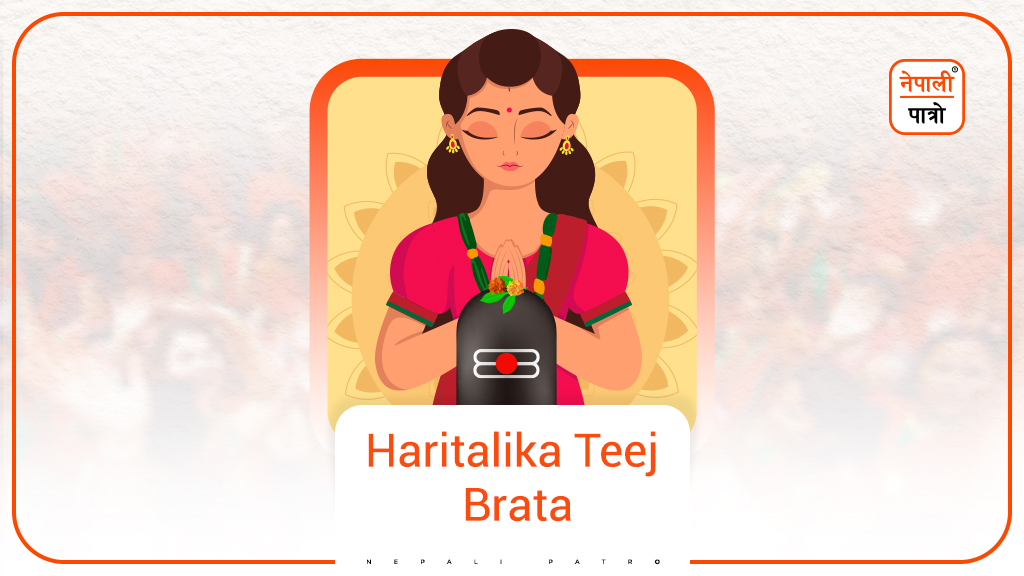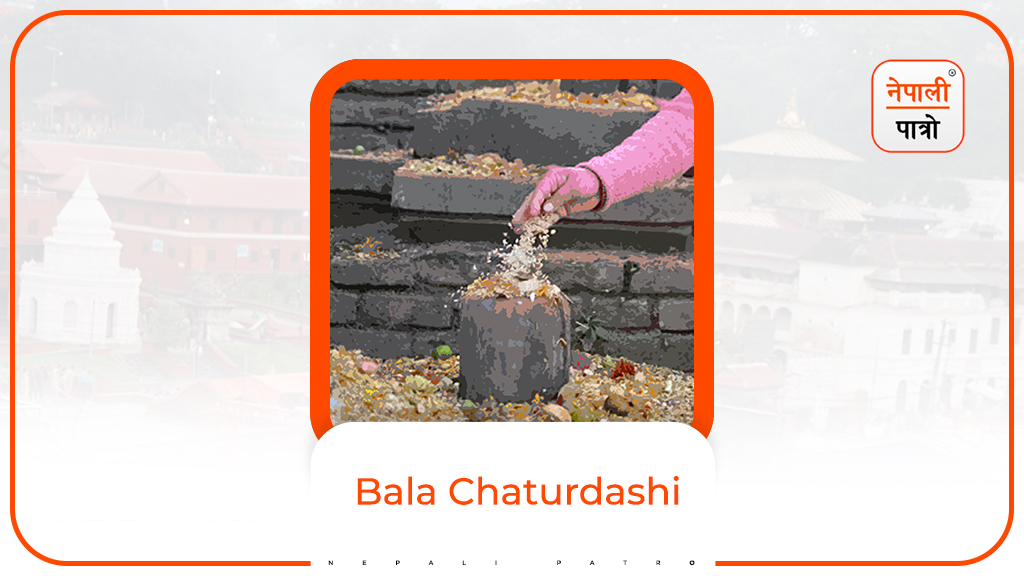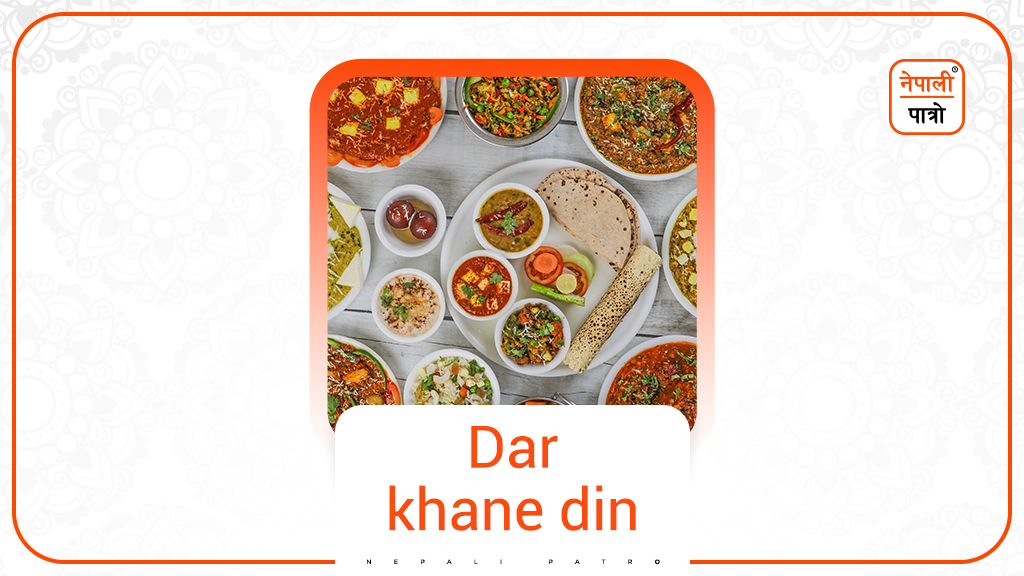
Haritalika Teej
Haritalika Teej. The third day of the month of Bhadra Sukla Pakchya is called Haritalika. ‘Harit’ means “abducted by” and ‘alika’ means friend. According to mythology, the day of Bhadra Shukla Tritiya is called Haritalika because Parvati, the daughter of the mountain king Himalaya, was abducted and hidden by her friends to save her from the arranged marriage with lord Bishnu.
आलिभिः सखिभिः हरिता इति हरितालिका।
or
सखिभिर्हरिता यस्मात् तेनेयं हरितालिका।
The popular name of Haritalika is Teej. This is a festival celebrated especially by women. Religiously, fasting includes worshiping Uma- Maheshwar and eating the next day after concluding the fast. There is a provision to fast and worship Lord Shiva along with Parvati on this day. Besides, special meals, dances, and entertainment are also offered at Teej. This festival is celebrated in Nepal, India, and other countries where Hindus live. In Teej, it is customary to cook the sweets by oneself and invite relatives to eat and feed the fruits of one’s labor. Teej is also at the forefront as a festival to buy new clothes and jewelry.
Teej has been considered an important festival in Nepali society since time immemorial. Teej allows daughters-in-law and nieces who had gone away after getting married at an early age, to go parental home (Maiti), gather together, eat sweets and delicious food amid pleasant meetings, fast, perform mass worship and express their sorrows through dance and songs. On this occasion, in the parental home, the sisters are able to express their pain and frustration with their in-laws via Teej Songs. Therefore, there is still a tradition in Teej to sing songs of sympathy and love for one’s parents by expressing the story of the incidents that took place in a foreign land or foreign house.
This festival can deepen the bond between husband and wife, express the spirit of mutual support directly, proving that husband and wife complement each other through the worship of Uma and Maheshwar, and get the desired fruit through the worship of God. Rising above being a couple, this festival is associated with the social aspect too. The relationship between mother-in-law and sister-in-law at home should not be bitter but be sweet and deep.
The parents have a big role to play in raising awareness of the fact that taking out practical issues inside the home can actually bring disgrace to one’s own home and add an outsider to domestic discord. The lesson of avoiding family hatred can also be learned from this festival. Going beyond this, trying to connect the dependents in our home and inviting grandparents, aunts, and uncles, friends, relatives to meet and have a generous meal and have fun with a sense of cooperation are awakened.
Nowadays, especially in the city, Teej is starting to appear as an ugly and expensive festival. Celebration since months before, and a lot of competition to get cassettes of commercial songs, etc is making it different from before. Original Teej has been distorted by the trend of singing commercial and lewd songs, showing off fashionable clothes and jewelry, worshiping to show off, and organizing mass catering in the name of Dar Khane Din for months. Everyone must be aware of such distortions and preserve the originality of Teej.
Religious Aspects and Rituals
On the third day of Bhadra Shukla Pakchya, Parvati’s vow to Lord Shiva to get a husband like him is followed by the tradition of Teej. When Parvati’s thoughts, meditation, worship, chanting, penance were centered on Lord Mahadev, at Narad’s request, her father Parvatraj Himalaya decides to marry her to Lord Bishnu.
वासुदेव स्वयं देवः कन्यां प्रार्थयते यदि।
तदा मया प्रदातव्या त्वदागमनगौरवात्।।
Parvati was in excruciating pain when she found out that her father had decided that she should marry Lord Bishnu against her will. She shared her pain with her friends. The friends decided to hide Parvati and took her away to the forest. The news of Parvati’s disappearance caused a commotion in the palace of Parvatraj. In this way, Parvati performed penance to Ashutosh Lord Shiva while being in her friends’ hiding. She worshiped Lord Shiva by making a Shivalinga of sand and by pleasing Lord Shiva with the mantra chanting “Om Namah Shivaya. In the end, she received the same Lord as a Gift. Thus, the worship performed by Parvati is called Haritalika Puja.
There is a provision to worship Shiva-Parvati together after worshiping Deep – Kalash – Ganesh during Teej or Haritalika. Prestigious shiva-lingam or newly made by metal, stone, etc., or Shivaling of sand and idols or pictures of Shiva Parvati can also be worshiped. If the idol or Shiva-linga is new, the worship should be started by paying homage (pranpratistha) to it and if it is one being worshiped daily, it should be started by meditating on it.
Brief worship method of Haritalika
Meditation Mantra of Uma-maheshwar:
मन्दारमाला–कुलितालकायै
कपाल–मालाङ्कितशेखराय।
दिव्याम्बरायै च दिगम्बराय
नमः शिवायै च नमः शिवाय।।
Worship Shodshopachar –
ध्यानं समर्पयामि, उमामहेश्वराभ्यां नमः।
आवाहनं समर्पयामि, उमामहेश्वराभ्यां नमः।
आसनं समर्पयामि, उमामहेश्वराभ्यां नमः।
पाद्यं समर्पयामि, उमामहेश्वराभ्यां नमः।
अर्घ्यं समर्पयामि, उमामहेश्वराभ्यां नमः।
आचमनीयं समर्पयामि, उमामहेश्वराभ्यां नमः।
पञ्चामृतं समर्पयामि, उमामहेश्वराभ्यां नमः।
शुद्धोदकं समर्पयामि, उमामहेश्वराभ्यां नमः।
वस्त्रं समर्पयामि, उमामहेश्वराभ्यां नमः।
यज्ञोपवीतं समर्पयामि, उमामहेश्वराभ्यां नमः।
उपवस्त्रं समर्पयामि, उमामहेश्वराभ्यां नमः।
वस्त्रयज्ञोपवीतान्ते आचमनीयं समर्पयामि, उमामहेश्वराभ्यां नमः।
चन्दनं समर्पयामि, उमामहेश्वराभ्यां नमः।
श्वेताक्षताः समर्पयामि, उमामहेश्वराभ्यां नमः।
पुष्पमालां समर्पयामि, उमामहेश्वराभ्यां नमः।
विल्वपत्राणि समर्पयामि, उमामहेश्वराभ्यां नमः।
पार्वतीप्रीतये सौभाग्यद्रव्याणि सिन्दूरञ्च समर्पयामि, उमामहेश्वराभ्यां नमः।
Anga worship –
ॐ शङ्कराय नमः, पादौ पूजयामि।
ॐ महेश्वराय नमः, जङ्घे पूजयामि।
ॐ शम्भवे नमः, जानुनी पूजयामि।
ॐ भूतेशाय नमः, उरू पूजयामि।
ॐ नीललोहिताय नमः, कटिं पूजयामि।
ॐ उग्राय नमः, नाभिं पूजयामि।
ॐ कृशानुरेतसे नमः, उदरं पूजयामि।
ॐ हराय नमः, स्तनौ पूजयामि।
ॐ नीलकण्ठाय नमः, कण्ठं पूजयामि।
ॐ शिवाय नमः, मुखं पूजयामि।
ॐ त्रिनेत्राय नमः, नेत्रे पूजयामि।
ॐ रुद्राय नमः, कर्णौ पूजयामि।
ॐ ललाटाक्षाय नमः, ललाटं पूजयामि।
ॐ शर्वाय नमः, शिरः पूजयामि।
ॐ शम्भवे नमः, सर्वाङ्गं पूजयामि।
Name worship–
ॐ उमायै नमः। ॐ गौर्यै नमः।
ॐ पार्वत्यै नमः। ॐ जगद्धात्र्यै नमः।
ॐ जगत्प्रतिष्ठायै नमः। ॐ शान्तिरूपिण्यै नमः।
ॐ हराय नमः। ॐ महेश्वराय नमः।
ॐ शम्भवे नमः। ॐ शूलपाणये नमः।
ॐ पिनाकधृषे नमः। ॐ शिवाय नमः।
ॐ पशुपतये नमः। ॐ महादेवाय नमः।
After that–
धूपं समर्पयामि, उमामहेश्वराभ्यां नमः।
दीपं दर्शयामि, उमामहेश्वराभ्यां नमः।
नैवेद्यं समर्पयामि, उमामहेश्वराभ्यां नमः।
नैवेद्यान्ते आचमनीयं समर्पयामि, उमामहेश्वराभ्यां नमः।
फलं समर्पयामि, उमामहेश्वराभ्यां नमः।
ताम्बूलं समर्पयामि, उमामहेश्वराभ्यां नमः।
दक्षिणाद्रव्यं समर्पयामि, उमामहेश्वराभ्यां नमः।
आभूषणं समर्पयामि, उमामहेश्वराभ्यां नमः।
नीराजनं समर्पयामि, उमामहेश्वराभ्यां नमः।
कर्पूरार्तिक्यं समर्पयामि, उमामहेश्वराभ्यां नमः।
पुष्पाञ्जलिं समर्पयामि, उमामहेश्वराभ्यां नमः।
प्रदक्षिणां समर्पयामि, उमामहेश्वराभ्यां नमः।
नमस्कारान् समर्पयामि, उमामहेश्वराभ्यां नमः।
प्रार्थना समर्पयामि, उमामहेश्वराभ्यां नमः।
क्षमापनं समर्पयामि, उमामहेश्वराभ्यां नमः।
By performing this method, one should perform Uttarang Puja the next morning and donate the purna patro and conclude the fast.
In this process, sages as Lopamudra and Agastya should be worshiped and Arghya should be given to Uma – Maheshwar.
The Mantra of Uma- Maheshwar while giving Arghya–
श्रीपार्वती महाभागे शङ्करप्रियवादिनि।
अर्घ्यं गृहाण कल्याणि भर्त्रा सह पतिव्रते।।
श्री उमामहेश्वराभ्यां नमः अर्घ्यं निवेदयामि।
Mantra to conclude the brat/fast–
उपवासो व्रतं चैव दानं तीर्थं जपं तपः।
विप्रैः सम्भाषितं यद्यत्तत्सर्वं सफलं भवेत्।।
Note: For the entire method of fast and fasting of Haritalika Teej, help can be taken from the scriptures like Bratraj, etc. Since Ganesh Chaturthi falls on the next day of Teej, worship, darshan, adoration, an offering of Durvangkur, etc. should be done to Ganesh as well.
To Read this article in the Nepali Language please click here. Haritalika Teej



September 6, 2024 1 year
Thank you, Nepali Patro Team and Community, for the incredible work you’ve done in sharing authentic stories, explaining rituals, and enlightening us through scientific studies and continuous research.
I always look forward to reading such insightful and knowledgeable writings from you.
Thank you for taking on the responsibility of providing a wealth of knowledge about our religion, culture, festivals, and rituals. The younger generation should definitely follow your lead.